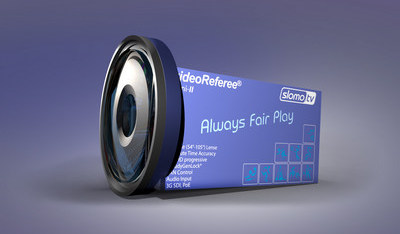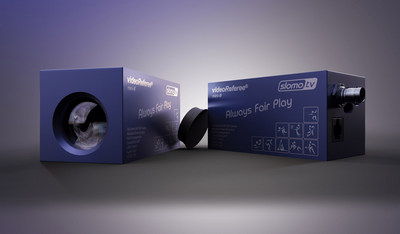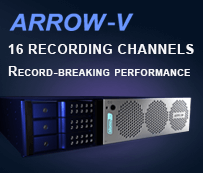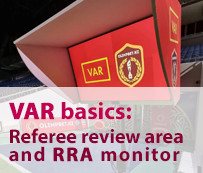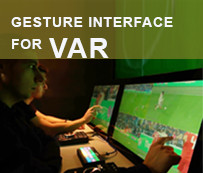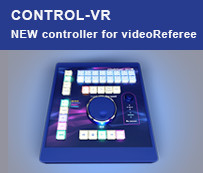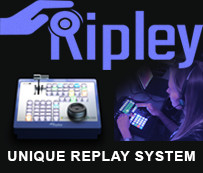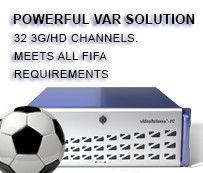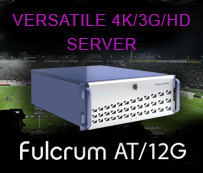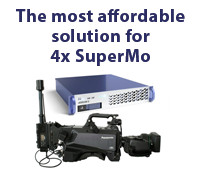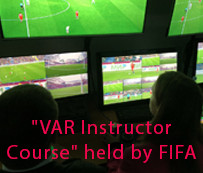Any video-refereeing system involves recording from cameras. At first VAR was using signals from TV broadcaster cameras. These cameras provide high-quality images and, as a rule, work synchronously: they produce the same number of frames in the same time period and their shutters are triggered simultaneously. However, they are controlled by cameramen and it may turn out that although the system recorded many cameras, the video needed for review is simply missing. We also shouldn’t forget that the broadcaster might not be present at all competitions.
Based on these factors, the most appropriate solution is to use for VAR systems the dedicated cameras. This allows placing the cameras in the designated locations that provide the most complete overview of the field, targeting them at the desired area or object, and setting the correct viewing angle. The optimal positioning of cameras also allows minimizing the number of the recording channels. There is no need to worry that a certain moment will not be recorded.
Since adding cameras leads to additional costs, one of the requirements is cameras at an affordable price. In this regard, the cameras that output SDI video and IP cameras are considered.
IP cameras - not the best choice for a VAR system
Low cost and a wide product range are the main advantages of IP cameras. They are connected with a widely available standard twisted-pair cable. However, nowadays IP cameras are quite rarely used in video-refereeing for a very simple reason: these cameras are not synchronous and the transmission of video over IP makes the task of synchronizing video streams difficult to implement. This makes them unsuitable for analyzing the moments, which are related to timing or require determination of the object's position at a certain point in time.
What does this mean? Let's take a look at the 24-second rule in basketball. If a throw is made before the end of the attack time, it counts. But what if it happens at the last second? With the IP camera, we cannot accurately determine the point in time. This can lead to a wrong decision. The situation will not change even if one camera captures the scoreboard, because the cameras remain not synchronized by frame and by phase. Similar difficulties will also exist with identifying the offside position in soccer since it is not possible to match the frames and determine the position of the objects.
Another significant disadvantage of IP cameras is a consequence of their advantage. The camera outputs a compressed video stream with a low bitrate (with IP codecs - MPEG 2, H.264 or H.265). On the one hand, this allows recording more information to the server's disk array, but on the other hand, it is difficult to search frame-by-frame, especially simultaneously on several cameras.
In fact, one of the basic modes of video-refereeing - Synchronous Multiscreen - becomes unavailable. Currently, there is no tool that can provide all existing and needed VAR functionality with IP cameras. There is no doubt that these problems will be solved in the near future, but for the moment these factors remain crucial.
Basic requirements for the cameras
Currently, the most suitable cameras for video-refereeing are those that output uncompressed video signals in real time, so most VAR systems now use cameras with SDI outputs.
What should be considered when choosing an SDI camera? First, the camera must provide the desired viewing angle and control of zoom and focus. Cheap cameras without a built-in zoom lens require a separate lens, which is selected depending on the sport and arena. It makes the camera cheaper, but does not provide all the features of the built-in lens. The use of cameras with external lenses for portable VAR systems is complicated, because the size and geometry of the areas can vary.
Cameras installed in a hard-to-reach location, such as under the roof of an arena for over-the-goal view, need to use a built-in Zoom lens with remote control support. Otherwise, it is almost impossible to adjust it during the match.
Often there is not enough light in arenas. For this reason, cameras should be sensitive enough to work with shutter speeds of 1/100, 1/200, 1/500 without the Dynamic Noise Reduction algorithm, which can cause visual errors.
Because images from the video-refereeing cameras are sometimes included in TV broadcasts, the ability to also control the camera settings, such as color correction, is an additional advantage.
How should the camera control be properly organized? The optimal solution is to do it via Ethernet. This requires standard, inexpensive and common cables. In addition, you can use the existing infrastructure of the facility. Ethernet has many advantages over specialized data interfaces (RS-422, RS-232, etc.)
The most convenient way to control the cameras is to do it from the server software. No additional equipment is required, the operator can quickly configure the camera and unlike external consoles, settings cannot be lost.
The same Ethernet cable can also be used to power the camera using Power over Ethernet technology (PoE). This not only avoids additional cabling, but is also useful for mobile VAR systems because there may not be a standard power source near the camera.
The availability of a Power Bank is also an advantage.
If cameras can operate in sync mode, they are ideal for the video-refereeing applications.
The sport specifics
For some sports there are additional camera requirements. So, when working with water sports cameras should allow the installation of a polarizing filter. Otherwise, the light glares from the water surface will complicate the process. The same applies to ice hockey.
PTZ cameras
PTZ cameras have a controllable lens and are often waterproof. Pan, tilt and zoom adjustments of these cameras can be accidentally changed (let's not exclude the human factor).
Despite being more expensive than cameras without PT capability, PTZ cameras are suitable for video-refereeing (e.g. Panasonic AW-HE42).
Super Slow Motion cameras usage
Everything mentioned earlier applies to the standard speed cameras. However, SSM cameras, which provide more frames per second, require a more powerful server with more recording channels, better processor and larger storage capacity.
The 2x cameras use 2 SDI recording channels or require specialized interfaces such as HDMI 2.0, which does not transmit the signal over long distances.
A sensible idea is to use SSM cameras in certain areas, for example, on the "blue lines" in hockey to analyze the "offside" position. But it should be understood that for situations in which the position of objects at a particular point in time plays a key role, only synchronous with each other SSM cameras should be used without considering the standard cameras.
Let's review an offside situation in soccer. While a normal camera generates one frame, the SSM camera generates two frames. On the normal camera we will see the kick, and the first frame from the SSM camera will show no offside but the second frame will show the player in offside position. Which frame should we believe? The referee should not make this choice, everything must be accurate.
For such situations you need an elaborate set of synchronous SSM cameras.
As an example of cameras specially designed to work in VAR systems, you might consider the slomo.tv mini-II-vR-Cam.
It provides Cloud Genlock, built-in 10x/3x Zoom lens, PoE or micro-USB; control via Ethernet of Zoom, Focus, IRIS, Exposition, and Color Correction.



